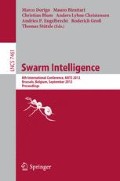Abstract
Ants use individual memory and pheromone communication to forage efficiently. We implement these strategies as distributed search algorithms in robotic swarms. Swarms of simple robots are robust, scalable and capable of exploring for resources in unmapped environments. We test the ability of individual robots and teams of three robots to collect tags distributed in random and clustered distributions in simulated and real environments. Teams of three real robots that forage based on individual memory without communication collect RFID tags approximately twice as fast as a single robot using the same strategy. Our simulation system mimics the foraging behaviors of the robots and replicates our results. Simulated swarms of 30 and 100 robots collect tags 8 and 22 times faster than teams of three robots. This work demonstrates the feasibility of programming large robot teams for collective tasks such as retrieval of dispersed resources, mapping, and environmental monitoring. It also lays a foundation for evolving collective search algorithms in silico and then implementing those algorithms in machina in robust and scalable robotic swarms.
Access this chapter
Tax calculation will be finalised at checkout
Purchases are for personal use only
Preview
Unable to display preview. Download preview PDF.
References
Bailis, P., Nagpal, R., Werfel, J.: Positional communication and private information in honeybee foraging models. Swarm Intelligence, 263–274 (2010)
Banerjee, S., Moses, M.: Scale invariance of immune system response rates and times: perspectives on immune system architecture and implications for artificial immune systems. Swarm Intelligence 4(4), 301–318 (2010)
Beverly, B., McLendon, H., et al.: How site fidelity leads to individual differences in the foraging activity of harvester ants. Behavioral Ecology 20(3), 633–638 (2009)
Bonabeau, E., Dorigo, M., Theraulaz, G.: Swarm intelligence: from natural to artificial systems. Oxford University Press, USA (1999)
Cao, Y., Fukunaga, A., Kahng, A.: Cooperative mobile robotics: Antecedents and directions. Autonomous Robots 4(1), 7–27 (1997)
Deneubourg, J., Goss, S., Franks, N., Sendova-Franks, A., et al.: The dynamics of collective sorting robot-like ants and ant-like robots. In: From Animals to Animats: Proc. of the 1st Int’l Conf. on Simulation of Adaptive Behavior, pp. 356–363 (1991)
Dorigo, M., Floreano, D., et al.: Swarmanoid: a novel concept for the study of heterogeneous robotic swarms. Tech. rep., Technical Report TR/IRIDIA/2011-014, IRIDIA, Université Libre de Bruxelles, Brussels, Belgium (2011)
Dorigo, M., Sahin, E.: Swarm robotics–special issue editorial. Autonomous Robots 17(2-3), 111–113 (2004)
Dorigo, M., Trianni, V., Şahin, E., Groß, R., Labella, T., et al.: Evolving self-organizing behaviors for a swarm-bot. Autonomous Robots 17(2), 223–245 (2004)
Flanagan, T., Letendre, K., Moses, M.E.: Quantifying the Effect of Colony Size and Food Distribution on Harvester Ant Foraging. PLoS ONE (in review)
Flanagan, T., Letendre, K., et al.: How Ants Turn Information into Food. In: Proceedings of the 2011 IEEE Conference on Artificial Life, pp. 178–185 (2011)
Gordon, D.: The spatial scale of seed collection by harvester ants. Oecologia 95(4), 479–487 (1993)
Hölldobler, B.: Recruitment behavior, home range orientation and territoriality in harvester ants, Pogonomyrmex. Behav. Ecol. and Sociobio. 1(1), 3–44 (1976)
Krieger, M., Billeter, J., Keller, L.: Ant-like task allocation and recruitment in cooperative robots. Nature 406, 992–995 (2000)
Letendre, K., Moses, M.E.: Ant foraging strategies: Site fidelity and recruitment alone and in combination (in review)
Mayet, R., Roberz, J., Schmickl, T., Crailsheim, K.: Antbots: A feasible visual emulation of pheromone trails for swarm robots. Swarm Intell., 84–94 (2011)
Moeslinger, C., Schmickl, T., Crailsheim, K.: Emergent flocking with low-end swarm robots. Swarm Intelligence, 424–431 (2011)
Mondada, F., Pettinaro, G., Kwee, I., Guignard, A., Gambardella, L., Floreano, D., Nolfi, S., Deneubourg, J., Dorigo, M.: SWARM-BOT: A swarm of autonomous mobile robots with self-assembling capabilities. In: Proc. of the Intl. Workshop on Self-organisation and Evolution of Social Behaviour, pp. 307–312 (2002)
Moses, M., Banerjee, S.: Biologically Inspired Design Principles for Scalable, Robust, Adaptive, Decentralized Search and Automated Response (RADAR). In: Proceedings of the 2011 IEEE Conference on Artificial Life, pp. 30–37 (2011)
Moses, M.: Metabolic scaling from individuals to societies. Ph.D. thesis, University of New Mexico (2005)
Mull, J., MacMahon, J.: Spatial variation in rates of seed removal by harvester ants (Pogonomyrmex occidentalis) in a shrub-steppe ecosystem. Am. Nat. (1997)
Nolfi, S., Florin, D.: Evolutionary robotics: The biology, intelligence, and technology of self-organizing machines. MIT Press (2000)
Parker, L.: Designing control laws for cooperative agent teams. In: IEEE International Conference on Robotics and Automation, pp. 582–587. IEEE (1993)
Sharkey, A.: Robots, insects and swarm intelligence. Artificial Intelligence Review 26(4), 255–268 (2006)
Trianni, V., Nolfi, S.: Engineering the Evolution of Self-Organizing Behaviors in Swarm Robotics: A Case Study. Artificial Life 17(3), 183–202 (2011)
Wittlinger, M., Wehner, R., Wolf, H.: The ant odometer: stepping on stilts and stumps. Science 312(5782), 1965 (2006)
Author information
Authors and Affiliations
Editor information
Editors and Affiliations
Rights and permissions
Copyright information
© 2012 Springer-Verlag Berlin Heidelberg
About this paper
Cite this paper
Hecker, J.P., Letendre, K., Stolleis, K., Washington, D., Moses, M.E. (2012). Formica ex Machina: Ant Swarm Foraging from Physical to Virtual and Back Again. In: Dorigo, M., et al. Swarm Intelligence. ANTS 2012. Lecture Notes in Computer Science, vol 7461. Springer, Berlin, Heidelberg. https://doi.org/10.1007/978-3-642-32650-9_25
Download citation
DOI: https://doi.org/10.1007/978-3-642-32650-9_25
Publisher Name: Springer, Berlin, Heidelberg
Print ISBN: 978-3-642-32649-3
Online ISBN: 978-3-642-32650-9
eBook Packages: Computer ScienceComputer Science (R0)

